Multiple Sclerosis (MS) is a leading cause of disability, affecting more than a million people in the US. There is no cure for MS, but there are treatments that can help slow the progression of the disease. [1] Exoskeletons present a more advanced and better rehabilitation solution for patients with MS to recover their mobility skills. And with the recent FDA approval, they might become an integral rehabilitation method in rehabilitation centers. This article explores multiple sclerosis, its causes, symptoms, and the application of exoskeletons in the treatment of MS.
What is Multiple Sclerosis?
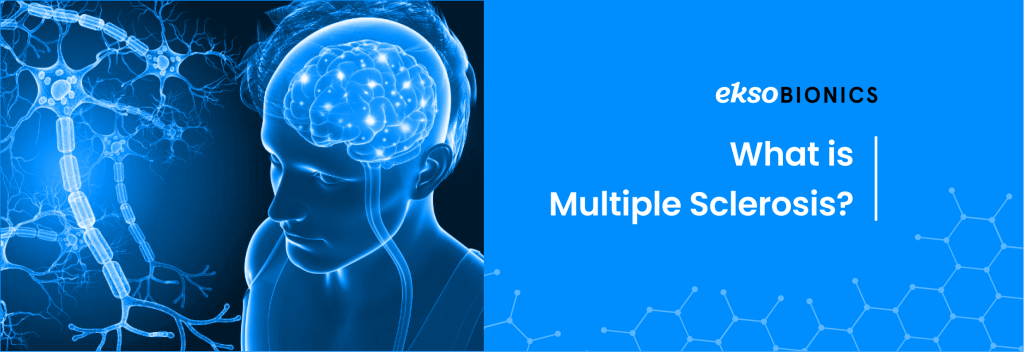
Multiple sclerosis is an inflammatory neurological condition that affects the central nervous system – optic nerves, spinal cord, and brain. It is commonly diagnosed in people who are between 20 years and 40 years. There is no known cause for MS, but research has shown that certain factors trigger the immune system to attack the central nervous system. The attack destroys myelin and damages the underlying nerve fiber. This disrupts communication signals from and to the brain, producing symptoms like memory problems, fatigue, paralysis, numbness, blindness, pain, etc. MS symptoms manifest differently in each patient, and they may be temporary or long-term. While there is no cure, medication and physical therapy can be used to manage its effects.
What Causes Multiple Sclerosis?
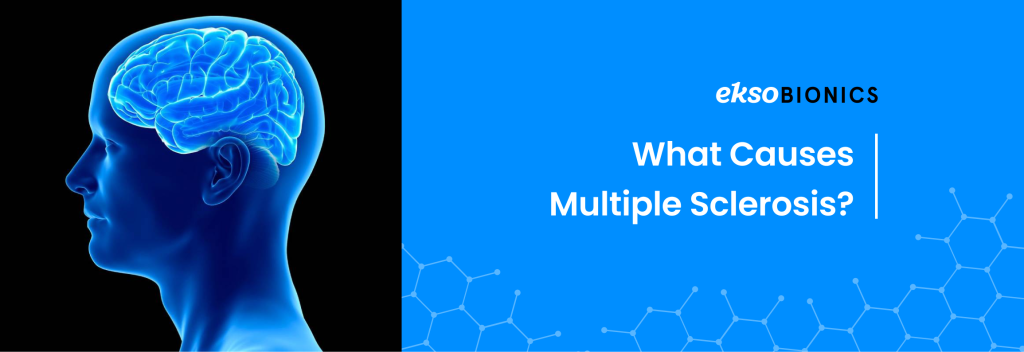
While the cause of MS has not been identified yet, researchers believe that different factors trigger it. Some factors under research include:
- Immunological factors: Abnormal immune response causes damage to the central nervous system. T cells and B cells are the two most prominent cells involved in the abnormal immune response.
- Environmental factors: According to research, MS occurs in areas that are farther away from the equator. Evidence shows vitamin D plays a critical role, and low vitamin D levels present a risk factor in developing the condition. Some scientists use sun exposure to explain the north-south distribution of MS, saying that people closer to the equator are exposed to more sunlight, hence lower MS prevalence. [2] However, epidemiologists are studying more patterns to establish a clear relationship.
Researchers believe smoking also plays a critical role in MS. Some studies show that smoking increases the risk of developing MS and contributes to severe symptoms and faster disease progression. [3]
- Infectious factors: MS is associated with many bacteria and viruses. Some of the bacteria and viruses under investigation in the development of MS include: canine distemper, Chlamydia pneumonia, human herpesvirus 6 (HHV-6), measles, and Epstein-Barr virus (EBV). A recent study shows that previous infection with EBV puts you at a higher risk of developing MS. [4]
- Genetic factors: MS is not passed down from one generation to another. However, researchers are investigating the genetic risk of inheritance. The risk of developing MS in a general population sample is about one in seven hundred and fifty, but the risk increases when first-degree relatives like parents and siblings have MS.
What Are the Symptoms of Multiple Sclerosis
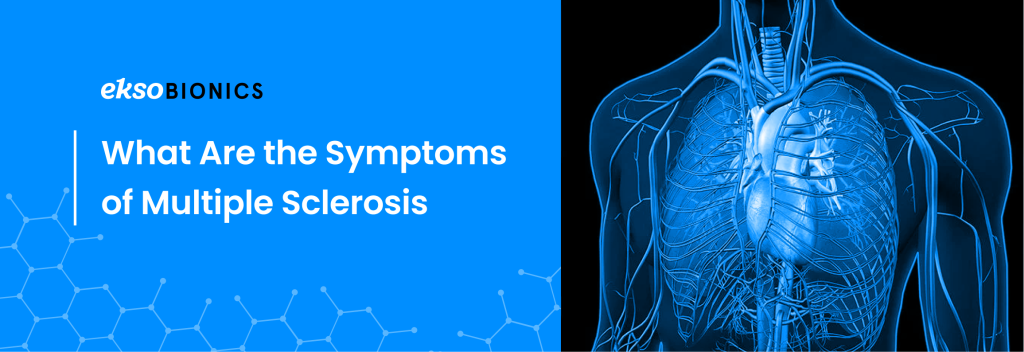
Multiple Sclerosis symptoms are different in each person, and they can change over time. Some people only experience one symptom, while others experience numerous symptoms. Some of the symptoms commonly observed in people with MS include:
- MS Hug (Dysesthesia): This is the feeling of squeezing around the torso. It can be likened to a tight blood pressure cuff around the arm and is the most common first symptom.
- Fatigue: Occurs in 80% of patients and interferes with work performance and engagement at home.
- Numbness or Tingling: People with MS typically experience numbness of the body, arms, face, and legs.
- Vision Problems: This is a common first symptom in many people and can include eye problems like neuromyelitis optica, poor contrast, blurred vision, and pain when moving the eyes.
- Cognitive Changes: Cognitive changes can affect the ability to learn, recall, solve problems, pay attention, focus attention, and process information. This affects more than 50% of people with MS.
- Emotional Changes: Emotional changes result from neurologic changes, but sometimes they can be a result of the stress of living with the condition. These changes can be in the form of irritability, anxiety, mood swings, and uncontrollable laughing or crying.
- Walking (Gait) Difficulties: These mobility impairments are due to factors like fatigue, spasticity, and muscle weakness, among others, but medication, physical therapy, or assistive devices like exoskeletons can resolve them.
- Spasticity: This is the condition where there’s increased muscle stiffness and tone, which affects movement. It may also be accompanied by discomfort and pain
Exoskeletons for Multiple Sclerosis
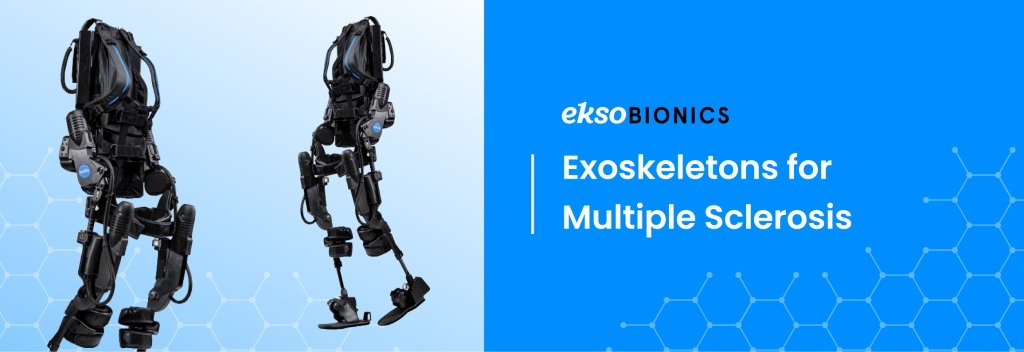
An exoskeleton is an external device a patient wears to enhance their endurance and support their mobility. It can be battery-powered or mechanical. It is used to help the wearer stand, walk, sit and move their legs. Battery-powered exoskeletons manipulate the knee and hip joints to initiate movement while the wearer gains balance support using their upper limbs. The wearer can operate the exoskeleton on their own or with the help of a physical therapist. Exoskeletons are great for rehabilitation because they can be customized to a patient’s specific needs and abilities.
EksoNR is the first and only exoskeleton cleared for the rehabilitation of people with MS by the FDA. It can also be used by patients recovering from a stroke, spinal cord injury, or acquired brain injury. EksoNR is uniquely different from other exoskeletons because it is not just an assistive device that provides all the power a patient needs to walk. Instead, its main focus is to help patients “walk out of the device and back into their communities”- Ekso Bionics Chairman and CEO Steven Sherman.
EksoNR is preprogrammed with specific movements that patients require during rehabilitation, like marching, weight shifting, squatting, and stepping. It also has therapist-programmed settings that can help set the amount of assistance based on the patient’s needs. Additionally, it has a cloud-based dashboard that records session data (speed, walking time, and distance) in real time. EksoNR is a game changer in rehabilitation, and it can help patients develop better balance, coordination, endurance, gait quality, and quality of life.
Benefits of Exoskeletons
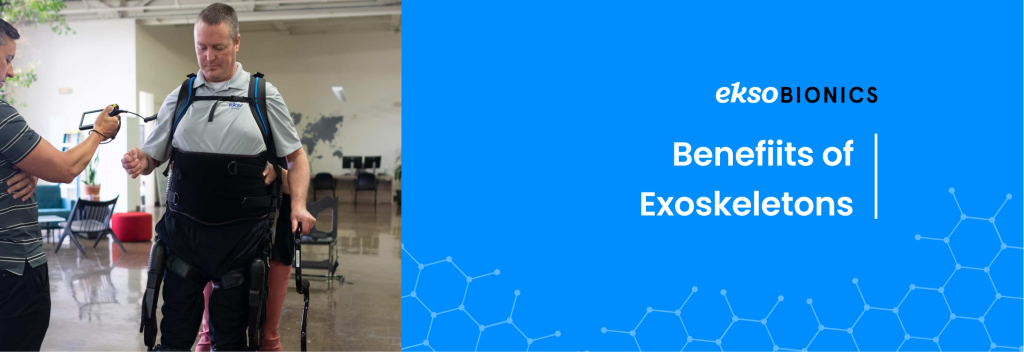
Using exoskeletons in physical therapy can help improve gait quality, muscle strength, and cognitive ability.
- Improved Gait Quality
In a study involving ten patients with MS, conducted by Kessler Foundation, patients were rehabilitated using an Ekso Bionics exoskeleton, and their recovery progress was compared to participants who used conventional gait training methods. The outcomes studied in this case were walking endurance, functional mobility, brain connectivity, and cognitive processing speed. After four weeks, the patients who used the exoskeleton were shown to have outperformed those who used conventional gait training methods. Additionally, these results were also corroborated by MRI brain scans. [5]
In a 2021 randomized controlled trial investigating how exoskeletons affect gait speed and functional mobility in individuals with multiple sclerosis (MS), the researchers concluded that exoskeletons could help preserve gait speed and improve functional mobility. [6]
- Increased Exercise Intensity
Over-exertion is a big concern for people with MS because it contributes to the progression of the disease. The question then becomes, how can patients train without overexerting themselves? Another part of this puzzle is attending to patients who might not be able to achieve the required intensity in their exercise program. According to Brian M. Sandroff, Ph.D., lead investigator and a Senior Research Scientist at the Kessler Foundation’s Exercise Neurorehabilitation Research Laboratory, “One of the big problems is that people with MS who have a severe disability status in terms of walking might not be able to exercise at a sufficient intensity to elicit benefits.” [7]
Exoskeletons offer the solution in these two instances as they can help patients train intensely without over-exertion, as evidenced in a 2021 study. [6] They can also help patients with severe mobility disabilities to attain the required intensity for their progress. An exoskeleton like EksoNR allows physical therapists to customize the steps in each session, thereby reducing the possibility of over-exertion.
- Improved Muscle Strength
Exoskeletons are extremely helpful and can help patients with different degrees of injury increase their muscle strength. They can also help patients with leg weakness to stand, walk, squat, and perform other movements. In a 2015 study of patients with spinal cord injuries, patients were shown to achieve walk times ranging from 28 to 94 minutes, with some averaging a speed of up to 0.21m/s. [8]
- Improved Cognitive and Emotional State
Exoskeleton benefits go beyond physical improvements. They also affect a patient’s mental abilities. The direct involvement required from patients during the rehabilitation period can produce a psychological effect. Some exoskeletons like EksoNR keep track of a patient’s progress, and showing patients positive progress reports can help improve their hope and boost their morale.
Testimonial
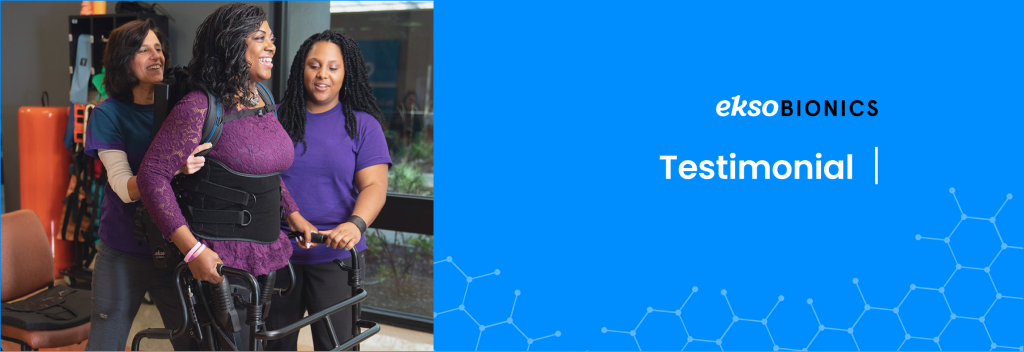
Kathy Miska was diagnosed with MS more than 20 years ago. Over the past few years, Kathy’s symptoms have worsened and impacted her ability to walk. But thanks to exoskeletons, she can now practice and improve her mobility skills. She is one of the patients with MS at Cleveland Clinic’s Mellen Center for Multiple Sclerosis, participating in a study investigating the effectiveness of exoskeletons in MS rehabilitation.
Kathy reports, “My walking speed has increased, my endurance has improved, my gait is more normal, and I get intermittent periods of my leg getting signals from my brain,” After completing a total of 24 hours in the Ekso exoskeleton, over eight weeks, Kathy says, “I feel like I have really made progress. My posture looks better, and my walking has improved. Hopefully, this will get me stronger. It’s encouraging.” [9]
Conclusion

Introducing advanced technology in your rehabilitation center will help your patients achieve better treatment outcomes and improve the quality of their life. We’d like to point out that the exoskeleton is not intended to take over the work for the patient but to stimulate “nerve memory” so that the muscles can be activated. We aspire to help patients recover their walking ability and walk right back into their lives.
Ekso Bionics is at the forefront of creating the best quality medical exoskeletons. Our mission is to create accessible mobility solutions for patients recovering from a stroke, brain injury, spinal cord injury, and MS. Would you like to outfit your rehabilitation center with one of our exoskeletons? Contact us at 510-984-1761 or request a free demo online.
References:
- Landmark Study Estimates Nearly 1 Million in the U.S. Have Multiple Sclerosis https://www.nationalmssociety.org/About-the-Society/News
- Vitamin D | National Multiple Sclerosis Society https://www.nationalmssociety.org/Research/
- Multiple Sclerosis and Smoking https://nms2cdn.azureedge.net/cmssite/nationalmssociety/media/
- Study Provides Strongest Evidence Yet for the Role of Epstein-Barr Virus in Triggering Multiple Sclerosis https://www.nationalmssociety.org/About-the-Society/News/
- A pilot randomized controlled trial of robotic exoskeleton-assisted exercise rehabilitation in multiple sclerosis https://www.msard-journal.com/article/
- Overground Robotic Program Preserves Gait in Individuals With Multiple Sclerosis and Moderate to Severe Impairments: A Randomized Controlled Trial https://pubmed.ncbi.nlm.nih.gov/33316225/
- Robotic Exoskeleton Therapy Shown To Improve Mobility And Cognition In People With MS https://www.forbes.com/sites/gusalexiou/2021/05/30/
- Time and Effort Required by Persons with Spinal Cord Injury to Learn to Use a Powered Exoskeleton for Assisted Walking https://pubmed.ncbi.nlm.nih.gov/26364280/
- Robotic Device May Make Walking Easier for Multiple Sclerosis Patients https://my.clevelandclinic.org/patient-stories/